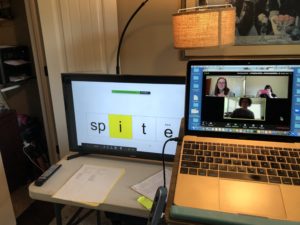This summer, I pondered the trials and tribulations of an unprecedented year, one that brought us a mix of digital learning, hybrid learning, and in-person learning. My mind trailed back to the Spring break of 2020, when we said goodbye to the students for one week of vacation and did not return to the classroom for the rest of the year.
How unexpected and unimaginable. We moved from traditional learning in the classroom to digital learning online with 24 hours of notice. Scrambling to access appropriate learning platforms and resources, wondering how to differentiate from a distance, and taking in nearly 10 years worth of professional development hours in one month-I was one of many educators who did not back down from the challenge.
While we can attest that it was not easy, some teachers and administrators were able to identify silver linings, adopting some pedagogical changes that will linger even after we return to the brick and mortar classroom. We were all placed into a unique situation where we tried so many new things that we may have never uncovered otherwise.
All of the successful experiments and all of the failed attempts have only served to inform us for instruction in the future. My summer reflection left me with a few key takeaways. My most important lessons learned from the digital classroom.
Social-emotional learning surpasses all.
I have always placed an emphasis on relationship development in the classroom, but the removal of in-person learning caused me to think deeply about how teachers connect with students. The sudden physical separation from our school community posed a distinctive experience for students of different ages.
Although I never would have believed it, our relationships with our students became stronger in some ways. Unpredictably, the shear platform of the digital classroom gave us more opportunity to talk about connections in our lives, which created new bonds among us.
Like many teachers, I found myself meeting the family pets, a visiting grandmother, and otherwise having the rare opportunity of a pseudo home visit. It was easier to check in with every student in front of me with facial expressions and posture. We began every lesson with a brief check-in activity-a mood meter, compliments, or goal setting.
To ramp up the feeling of classroom community, time was built in for thoughtful conversation during a lunch-bunch or an opportunity to bring your pet to community morning meeting. Those connections were more important than ever and really seemed to keep things feeling “typical”.
Organization and structure are survival.
Like many teachers, I found that the majority of my students transitioned to remote learning pretty quickly. I was concerned about students who exhibited weak executive functions in the classroom, those who turn in late assignments, arrive to class unprepared, or chronically misplace their instructional materials.
How would these students fair? I quickly learned it was important for me to set the precedence to keep them organized and confident. On my end, I began classes with a checklist of expectations and a timeline. As we went through lessons, I checked them off-providing a visual means to the end.
I activated meta-cognitive strategies to “think out loud” about my organization processes, showing students my teaching supplies and portable area and announcing which items we would need for each lesson block. I gave students time to “pack up” at the end of class to ensure that their learning spaces were maintained and organized for the next class. My classes were predictable, but not boring-structured, but never dull.
On the student’s end, I brainstormed ideas for creating the portable learning space at home, recommending a space that was not already associated with eating, watching television, or sleeping. We identified a specific tracking system for assignments and even offered “study labs” where I offered help during a block of time where students could come in and out of the digital classroom.
Students thrive on voice and choice.
Student input is key for engaging in the digital classroom. Remote learning poses greater distractions, leaving the teacher more daunted to keep all students engaged. By giving students a voice in decision-making, the teacher empowers them to take ownership of their learning, and in turn, they are more motivated.
To boost voice and choice, I offered project menus, opportunities to spin the “wheel of choice,” various game formats for learning, and allowed students opportunities to rate new digital activities and to learn platforms as we tried them.
Keep reading alive
One concern that I was reminded of during my reflection is that my students’ reading volume declined while they were away from the classroom. I had taken for granted all of the incidental minutes that are spent engaging with text in addition to our dedicated blocks of direct, explicit instruction.
The majority of my students were not maintaining a high volume of reading engagement, which was evident from the start. Finding ways to promote reading and fluency practice outside of our classroom time was essential. I am ever-grateful for the IMSE digital resources.
Using the animated blending board for the first time boosted motivation that was worth its weight in gold! My students were refreshed for the three-part drill and constantly looking to see what was new.
Everyone rises to the challenge.
Much to my surprise (and delight) and despite a few technology glitches along the way, I was incredibly impressed with how the students could engage flexibility, problem-solving, and tolerance in such a dynamic situation.
Looking back on their participation, I noticed that attendance was at an all-time high. The digital learning platform forced students to develop the necessary discipline essential to remote work, which is a growing aspect of a globalized economy. Undoubtedly, students have developed valuable skills and behaviors that will prove essential to success in their careers. 
All in all, there are many things from my digital classroom that have found a permanent place back in my traditional instruction. Teachers are still buzzing about the new tricks and tips they had learned while exploring the great, worldwide web.
I would have never imagined that I would engage Google slides, Flipgrid, emojis, podcasts, and even TikTok videos into one day’s lessons! Teachers in my learning community have their favorites, too. Some of their top picks included an endless array of virtual field trips and these top resources:
- Digital resources for Orton-Gillingham lessons.
- Free resources from IMSE.
- Super resource for field trips, lesson delivery, and virtual reality experiences.
About the Author
 Dr. Kirstina Ordetx is a Level 4 Master Instructor with The Institute for Multi-Sensory Education (IMSE). She holds a doctorate in Counseling Psychology with a concentration in pediatric neurology. Dr. Ordetx is an educational specialist with over 25 years of clinical experience, research, and consultation. She is a certified Structured Literacy Dyslexia Interventionist through the Center for Effective Reading Instruction, a Certified Nutrition and Wellness Consultant, Executive Functions Coach, and a registered Licensed Mental Health Intern. Dr. Ordetx has published two books that compile her research and practice in Theory of Mind. She has served on accreditation committees for the Florida Council of Independent Schools, is a university adjunct professor in developmental and child psychology, and presents at various national and international conferences. Dr. Ordetx is head of school for a private academy in Lakewood Ranch, Florida specializing in the multi-sensory education of students who have language and learning-based differences. She is the Executive Director of the Pinnacle Pediatric Therapy Group, a multi-disciplinary, pediatric therapy clinic.
Dr. Kirstina Ordetx is a Level 4 Master Instructor with The Institute for Multi-Sensory Education (IMSE). She holds a doctorate in Counseling Psychology with a concentration in pediatric neurology. Dr. Ordetx is an educational specialist with over 25 years of clinical experience, research, and consultation. She is a certified Structured Literacy Dyslexia Interventionist through the Center for Effective Reading Instruction, a Certified Nutrition and Wellness Consultant, Executive Functions Coach, and a registered Licensed Mental Health Intern. Dr. Ordetx has published two books that compile her research and practice in Theory of Mind. She has served on accreditation committees for the Florida Council of Independent Schools, is a university adjunct professor in developmental and child psychology, and presents at various national and international conferences. Dr. Ordetx is head of school for a private academy in Lakewood Ranch, Florida specializing in the multi-sensory education of students who have language and learning-based differences. She is the Executive Director of the Pinnacle Pediatric Therapy Group, a multi-disciplinary, pediatric therapy clinic.
